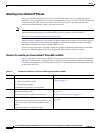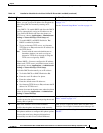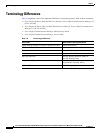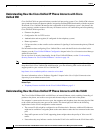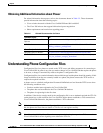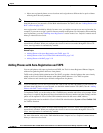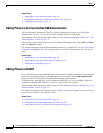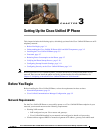
2-6
Cisco Unified IP Phone 8941 and 8945 Administration Guide for Cisco Unified Communications Manager 8.5 (SCCP and SIP)
OL-20851-01
Chapter
Understanding the Phone Startup Process
If you configure security-related settings in Cisco Unified CM Administration, the phone configuration
file will contain sensitive information. To ensure the privacy of a configuration file, you must configure
it for encryption. For detailed information, refer to the “Configuring Encrypted Phone Configuration
Files” chapter in Cisco Unified Communications Manager Security Guide. A phone requests a
configuration file whenever it resets and registers with Cisco Unified CM.
A phone accesses a default configuration file named XmlDefault.cnf.xml only when the phone has not
received a valid Trust List file containing a certificate assigned to the Cisco Unified CM and TFTP.
If auto registration is not enabled and you did not add the phone to the Cisco Unified CM database, the
phone does not attempt to register with Cisco Unified CM. The phone continually displays the
"Configuring IP" message until you either enable auto-registration or add the phone to the Cisco Unified
CM database.
If the phone has registered before, the phone will access the configuration file named
SEPmac_address.cnf.xml, where mac_address is the MAC address of the phone.
The filenames are derived from the MAC Address and Description fields in the Phone Configuration
window of Cisco Unified CM Administration. The MAC address uniquely identifies the phone.
For more information on phone configuration settings, go to the Cisco Unified IP Phone Configuration
chapter in the Cisco Communications Manager Administration Guide.
For more information also refer to the Cisco Unified Communications Manager Security Guide.
Understanding the Phone Startup Process
When connecting to the VoIP network, the Cisco Unified IP Phone 8941 and 8945 go through a standard
startup process that is described in
Table 2-3. Depending on your specific network setup, not all of these
steps may occur on your Cisco Unified IP Phone.
Table 2-3 Cisco Unified IP Phone Startup Process
Task Purpose Related Topics
1. Obtaining Power from the Switch
If a phone is not using external power, the switch
provides in-line power through the Ethernet cable
attached to the phone.
• Adding Phones to the Cisco Unified CM Database,
page 2-8.
• Resolving Startup Problems, page 9-1.
2. Loading the Stored Phone Image
The Cisco Unified IP Phone has non-volatile Flash
memory in which it stores firmware images and
user-defined preferences. At startup, the phone runs a
bootstrap loader that loads a phone image stored in
Flash memory. Using this image, the phone initializes
its software and hardware.
Resolving Startup Problems, page 9-1.
3. Configuring VLAN
If the Cisco Unified IP Phone is connected to a
Cisco Catalyst switch, the switch next informs the
phone of the voice VLAN defined on the switch. The
phone needs to know its VLAN membership before it
can proceed with the Dynamic Host Configuration
Protocol (DHCP) request for an IP address.
• Network Setup Menu, page 4-4.
• Resolving Startup Problems, page 9-1.



